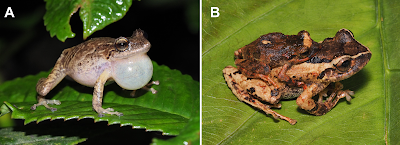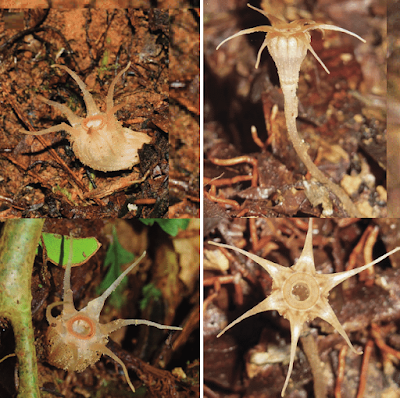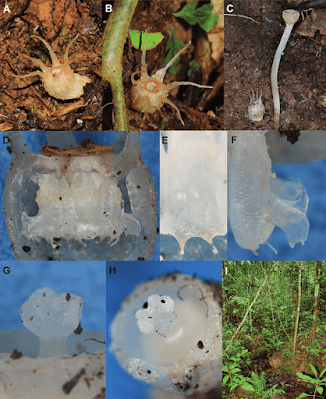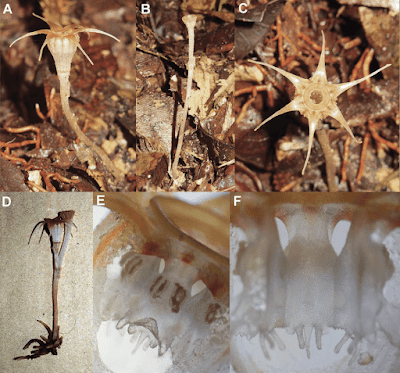[Most Recent Entries] [Calendar View]
Wednesday, November 10th, 2021
| Time | Event | ||||
| 12:04a | [Ichthyology • 2021] Apteronotus albertoi • The Description of A Rare and Critically Endangered Species of Ghost Knifefish (Gymnotiformes: Apteronotidae) from the Amazon Basin, Brazil
Abstract A new species of ghost knifefish is described from the Rio Uatumã at Cachoeira do Miriti, Amazon basin, Brazil. It is distinguished from all species of Apteronotus by the absence of a clear stripe from the chin to the dorsal portions of the head and/or dorsum, a reduced number of anal-fin rays (118–122), and by having four branchiostegal rays. More specifically, the new species resembles Apteronotus quilombola by the low number of anal-fin rays; however, the number of branchiostegal rays and several additional counts and measurements differentiate the species. Furthermore, the new species co-occurs with A. lindalvae, and it can be distinguished by the number of premaxillary teeth. The occurrence area of the new species was highly impacted after the construction of Balbina dam. Thus, considering the threats to the species and the restricted area of distribution, its conservation status was assessed as critically endangered. Apteronotus albertoi, new species Etymology.— The specific epithet albertoi (a patronym in genitive case) is in honor of Dr. Alberto Carvalho, who is the manager of the ‘‘Laboratorio Multiusuário de Processamento de Imagens de Microtomografia Computadorizada de Alta Resolução do Museu de Zoologia da Universidade de São Paulo,’’ in recognition of his kind support in generating lCT scan images for MZUSP researchers, especially for the project ‘‘Diversity and Evolution of the Gymnotiformes.’’ Geographical distribution.— Apteronotus albertoi is only known from its type locality, the Uatumã River at Cachoeira do Miriti, Amazon basin, Brazil (Fig. 3). Luiz Antônio Wanderley Peixoto, Guilherme Moreira Dutra, Aléssio Datovo, Naércio Aquino Menezes and Carlos David De Santana. 2021. The Description of A Rare and Critically Endangered Species of Ghost Knifefish from the Amazon Basin (Ostariophysi: Gymnotiformes: Apteronotidae). Ichthyology & Herpetology. 109(4); 1002-1009. DOI: 10.1643/i2020157 | ||||
| 12:48a | [Herpetology • 2021] Pristimantis lojanus • Our Unknown Neighbor: A New Species of Rain Frog of the Genus Pristimantis (Anura: Strabomantidae) from the City of Loja, southern Ecuador
Abstract We describe a new species of rain frog of the genus Pristimantis from the city of Loja, Southern Ecuador, based on an integrative taxonomy approach, combining molecular, morphological and bioacoustics data. Pristimantis lojanus sp. nov. is a medium sized species of the phylogenetically strongly supported P. phoxocephalus group, and its sister species is P. torresi. The new species can be easily distinguished from its closest congeners and morphologically similar species (that also have acuminate snout with a fleshy keel) by its characteristic advertisement call and morphological features (dorsum finely tuberculate with scattered larger tubercles, flanks without longitudinal lateral folds, no markings in axilla, groin or on concealed limb surfaces, and bronze iris). Additionally, we describe the advertisement call of its sister species, P. torresi. Finally, we detail the current situation of the amphibian species present in the city of Loja and its surroundings. Class Amphibia Linnaeus, 1758 Order Anura Fischer von Waldheim, 1813 Superfamily Brachycephaloidea Günther, 1858 Family Strabomantidae Hedges, Duellman, and Heinicke, 2008 Genus Pristimantis Jiménez de la Espada, 1870
Pristimantis lojanus sp. nov. Székely, Székely, Ordóñez-Delgado, Armijos-Ojeda, and Vörös Diagnosis :We assign this species to Pristimantis based on phylogenetic evidence (Fig 1) and on the general morphological similarity to other members of the genus. Pristimantis lojanus is a medium sized species, distinguished by the following combination of traits: (1) skin on dorsum finely tuberculated with scattered larger tubercles (in life the skin tuberculated texture is more evident); skin on venter coarsely areolate to areolate; discoidal fold weak; dorsolateral folds absent; low middorsal fold present; (2) tympanic annulus prominent and tympanic membrane differentiated, its length about 45% of the length of eye; supratympanic fold present, concealing the upper and posterior margin of the tympanum; (3) snout acuminate with a vertical keel in dorsal view, rounded or subacuminate and inclined posteroventrally in profile; canthus rostralis weakly concave in dorsal view, rounded in profile; (4) upper eyelid bearing several small tubercles, similar in size and shape with the ones from the dorsum, about 80% IOD in females and 90% IOD in males; cranial crests absent; (5) dentigerous processes of vomers prominent, oblique, ovoid or triangular, separated medially by distance lower than the width of processes; each processes bearing 4 to 7 teeth; (6) males with a large subgular vocal sac and round vocal slits; nuptial pads present; (7) Finger I shorter than Finger II; discs on fingers broadly expanded, truncate; circumferential grooves present; (8) fingers bearing lateral fringes (trait more evident in life); subarticular tubercles prominent; supernumerary palmar tubercles present; palmar tubercle usually partially divided into a larger (inner) and a smaller (outer) tubercles; thenar tubercle elliptical, larger than the inner palmar tubercle; (9) ulnar tubercles present; (10) heel with several small, rounded tubercles; outer edge of tarsus with a row of small tubercles; inner tarsal fold present; (11) inner metatarsal tubercle broadly ovoid, about 4x or 5x the size of subconical (in profile) outer metatarsal tubercle; supernumerary plantar tubercles present; (12) toes bearing broad lateral fringes (trait more visible in life); webbing basal; Toe V much longer than Toe III; discs on toes broadly expanded, truncate, about same size as those on fingers; circumferential grooves present; (13) in life, dorsum and flanks of various shades of brown or reddish brown, with or without whitish spots or blotches, with or without whitish interorbital bars; venter cream, whitish or yellowish, with or without dark flecks and blotches; no markings in axilla, groin or on concealed limb surfaces; iris bronze with fine black reticulations and a median, horizontal read streak; (14) SVL 28.5–44.3 mm in adult females (34.6 ± 5.39 SD, n = 10) and 26.2–30.4 mm in adult males (28.1 ± 1.43 SD, n = 6). Etymology: The species epithet refers to the type locality, the city of Loja, with the Latin suffix "-anus" meaning "belonging to". Common English name: Loja Rain Frog Common Spanish name: Cutín de Loja Distribution: Pristimantis lojanus is known from the city of Loja and its close vicinity (all the streams that flow into the city, but also parks like Parque Universitario de Educación Ambiental y Recreación “Francisco Vivar Castro” and private protected areas like Reserva Madrigal del Podocarpus), as well as from several other localities (Fig 12). We also have confirmed records (with DNA samples or call recordings) from San Lucas and its vicinities, Bosque Servio Aguirre Villamagua, Cerro Sacama, Abra de Zamora, Cajanuma, Cristal, and San Antonio de Paycapamba. The species was encountered at an altitudinal range between 1937 m (Cristal) and 2782 m (Bosque Servio Aguirre Villamagua) a.s.l., in evergreen lower montane forest and evergreen upper montane forest ecosystems. Paul Székely, Diana Székely, Leonardo Ordóñez-Delgado, Diego Armijos-Ojeda and Judit Vörös. 2021. Our Unknown Neighbor: A New Species of Rain Frog of the Genus Pristimantis (Amphibia: Anura: Strabomantidae) from the City of Loja, southern Ecuador. PLoS ONE. 16(10): e0258454. DOI: 10.1371/journal.pone.0258454 | ||||
| 1:22a | [Botany • 2018] Thismia cornuta & T. pallida (Thismiaceae) • Two New Species of Thismia subsect. Odoardoa from Borneo
Abstract Background – Two new species of the sect. Thismia subsect. Odoardoa, Thismia cornuta Hroneš, Sochor & Dančák and Thismia pallida Hroneš, Dančák & Rejžek, from Malaysian Borneo are described and illustrated. The former species is distributed in the Bario area of the Kelabit Highlands of Sarawak, and the latter occurs in the SAFE (Stability of Altered Forest Ecosystem) Project area, northwest of Tawau in Sabah. Methods – This study is based on field observations in several forest localities in Sarawak and Sabah and herbarium material deposited in SAN, SAR and OL. Both conventional herbarium techniques and comparison with protologues of described species were applied. Results – Thismia cornuta is morphologically closely related to T. inconspicua Sochor & Dančák from Brunei Darussalam and T. chrysops Ridl. from the Malay Peninsula but it differs from both species by the presence of only two appendages at apical margin of the connective, by horn-like projection on each side of the lateral appendage and by white colour of perianth tube. It was found at three localities and is preliminarily treated as endangered (EN). Thismia pallida is morphologically close to T. filiformis Chantanaorr. from Thailand but differs by the presence of five appendages at apical margin of connective, by box-shaped lateral appendage exceeding apex of connective and by shorter filiform appendage of perianth lobe. It was found at a single locality within twice logged secondary forest and it is preliminarily treated as critically endangered (CR). This is only the second record of Thismia species inhabiting secondary forests in tropical Asia. Keywords: Malesia; Mycoheterotrophy; Sabah; Sarawak; Tropical rain forest Thismia cornuta Hroneš, Sochor & Dančák, sp. nov. It differs from its congeners by the combination of following morphological characters: stem very short or absent, flower slightly zygomorphic, perianth tube white and verrucose out-side, annulus pinkish, only two appendages at apical margin of the connective and small horn-like projection arising from each side of the lateral appendage. Distribution – So far known only from the Bario area, Kelabit Highlands, Sarawak, north-western Borneo (possibly endemic). Etymology – From the Latin cornutus (horned). The name points to the horn-like projections on lateral appendage resembling horns on a Viking helmet, a morphological trait so far not known in the genus. Thismia pallida Hroneš, Dančák & Rejžek, sp. nov. Similar to Thismia filiformis Chantanaorr. but differs in the presence of 5 (vs. 3) appendages at apical margin of the con-nective, by box-shaped lateral appendage exceeding apex of the connective, by longer perianth tube and shorter append-ages of the perianth lobes. Distribution – So far known only from small population of seven individuals in twice selectively logged forest near SAFE Project base camp (LFE blocs), south of Danum Valley Conservation Area and northwest of Tawau, Sabah, at elevation c. 485 m a.s.l. Etymology – From the Latin pallidus. The name refers to the pale colour of the whole plant. Michal Hroneš, Martin Rejžek, Michal Sochor, Martin Svátek, Jakub Kvasnica, Zuzana Egertová, Joan T. Pereira, Reuben Nilus and Martin Dančák. 2018. Two New Species of Thismia subsect. Odoardoa (Thismiaceae) from Borneo. Plant Ecology and Evolution. 151(1); 110-118. DOI: 10.5091/plecevo.2018.1387 | ||||
| 1:24p | [Botany • 2021] Primula longistyla (Primulaceae) • A New Species from Yunnan, China
Abstract Primula longistyla, a new species of Primulaceae from Cangyuan County, Yunnan Province, China, is described and illustrated. This species is similar to P. densa, but differs clearly in that its leaves are densely white villous on both sides, homostylous flowers, exannulate corollas, longer corolla tube (2.5–2.8 cm long, ca 4 times as long as the calyx) and styles often obviously protruding from corolla tube. A comparison table of related species is provided. Keywords: Cangyuan, China, new species, Primula longistyla, Primulaceae, Yunnan  Primula longistyla X. D. Ma & J. Y. Shen, sp. nov. Etymology: This new species is named for its long style, usually exceeding the corolla. Distribution and habitat: This new species is currently only known from Sigangli Cave, Menglai Township, Cangyuan County, Yunnan Province, China, growing on the stone wall of the karst cave at about 1180 m a.s.l. Xing-Da Ma, Wen-Guang Wang, Ji-Pu Shi and Jian-Yong Shen. 2021. Primula longistyla (Primulaceae), A New Species from Yunnan, China. Nordic Journal of Botany. DOI: 10.1111/njb.03341 |
| << Previous Day |
2021/11/10 [Calendar] |
Next Day >> |
















